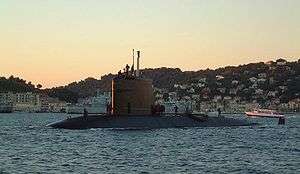Rubis-class submarine
 Casabianca in April 2005 | |
| Class overview | |
|---|---|
| Name: | Rubis class |
| Builders: | DCNS |
| Operators: |
|
| Preceded by: | Daphné class |
| Succeeded by: | Barracuda class |
| In commission: | 23 February 1983 |
| Planned: | 8 |
| Completed: | 6 |
| Cancelled: | 2 |
| Active: | |
| General characteristics | |
| Type: | Nuclear attack submarine |
| Displacement: |
|
| Length: | 73.6 m (241 ft) |
| Beam: | 7.6 m (25 ft) |
| Draught: | 6.4 m (21 ft) |
| Propulsion: |
|
| Speed: | over 25 kn (46 km/h; 29 mph) |
| Range: | Unlimited distance; 20–25 years |
| Complement: |
|
| Sensors and processing systems: |
|
| Armament: |
|
The Rubis type is a class of first-generation nuclear attack submarines of the French Navy. The class comprises six vessels and they are the most compact nuclear attack submarines to date. All submarines of the class (except for Casabianca) are named after gemstones.
History
Although the Rubis class belonged to the same generation as the Redoutable, due to President Charles De Gaulle's insistence on acquiring a nuclear deterrent for France, the Rubis program was started only in 1974, after the ballistic missile submarine program. The first Rubis hull was laid down in December 1976 and launched in 1979.
Proposed Canada-class
In 1987, the Canadian White Paper on Defence recommended the purchase of 10 to 12 Rubis or Trafalgar-class submarines under technology transfer, which would be known as the Canada-class.[2] with the choice of the type of submarine due to be confirmed before Summer 1988.[3] The goal was to build up a three-ocean navy and to assert Canadian sovereignty over Arctic waters.[4]
The Rubis-class as designed failed to meet the Canadian Statement of Requirement (SOR) as it was noisy underwater and slow. It also came with the caveat that the first 4-5 submarines would have to be built in France. Unlike the British Trafalgar-class, the Rubis design did not require USA permission to transfer the nuclear propulsion technology, as the Americans were certain to invoke their veto of the sale to Canada. The French brought back a revision to their design, added an "ice pick" so the submarine could operate under ice and were developing a modification for their torpedo tubes which were too short to use the Mark 48 torpedoes.[5] The purchase was finally abandoned in April 1989 due to high costs, particularly with the end of the Cold War.
AMETHYSTE rebuild
The initial design of the Rubis proved to be problematic with unexpectedly high noise levels. This led to the Améthyste silencing program (AMÉlioration Tactique HYdrodynamique Silence Transmission Ecoute, literally Silent Acoustic Transmission Tactical Hydrodynamic Amelioration) which was applied to the fifth (S605 Améthyste) and sixth (S606 Perle) hulls.
Améthyste and Perle were both longer that the original Rubis, 73.6 metres (241 ft) as compared with 72 metres (236 ft) and the program included upgrades to the sonar, reshaping of the hull form and bow to improve silencing and additional upgrades of the electronics. With the upgrades tested and proven, the original 4 boats were rebuilt to the same standards between 1989 and 1995.
 Silhouette before Améthyste rebuild
Silhouette before Améthyste rebuild Silhouette after Améthyste rebuild
Silhouette after Améthyste rebuild
Design
They have a central computer system for submarine detection, processing of information, and firing of weapons. The hull is made of 80 HLES high elasticity steel. The sonar dome and the conning tower are made of composite materials. The submarines have two crews, "Blue" and "Red", who man the ships every three months in turn.
They will be succeeded by the 2nd-generation Barracuda class.
Operational history
On 20 August 1993, Rubis collided with the oil tanker Lyria.[6] On 30 March 1994, Émeraude had a steam leakage, suffering 10 casualties.
During the Péan inter-allied manoeuvres of 1998, Casabianca managed to "sink" the aircraft carrier USS Dwight D. Eisenhower and the Ticonderoga-class cruiser that was escorting her.[7]
During COMPTUEX 2015, an exercise led by the US Navy, Saphir successfully defeated the aircraft carrier USS Theodore Roosevelt and its escort, managing to "sink" the US carrier. This was widely advertised by the French Navy but unmentioned by the US Navy.[8]
Gallery
References
- ↑ "SSN Rubis Amethyste Class, France". naval-technology.com. Retrieved 22 November 2014.
- ↑ Challenge and Commitment: A Defence Policy for Canada (PDF). Ottawa: Department of National Defence (Canada). 1987. pp. 52–54. ISBN 0-660-12509-9. Retrieved 23 July 2014.
- ↑ Defence Update 1988-89 (PDF). Ottawa: Department of National Defence (Canada). 1989. ISBN 0-662-55733-6. Retrieved 23 July 2014.
- ↑ Keith Spicer (10 September 2007). "Canada's Arctic claims". Ottawa Citizen. Retrieved 22 November 2014.
- ↑ Ferguson, p. 317-8
- ↑ Simons, Marlis (August 1993). "Oil Spills as Nuclear Sub Hits a Tanker Off France". New York Times. Retrieved 2008-06-14.
- ↑ "Sous-marin nucléaire d'attaque Casabianca" (in French). netmarine.net. 2012. Retrieved 22 November 2014.
- ↑ Lagneau, Laurent (4 March 2015). "Un sous-marin nucléaire d'attaque français a fictivement coulé le porte-avions USS Theodore Roosevelt". opex360.com (in French). Retrieved 18 May 2015.
External links
| Wikimedia Commons has media related to Rubis class submarine. |





